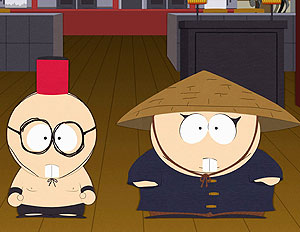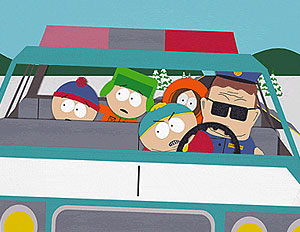Oh Hamburgers: Thoughts On South Park‘s 15-Year Run
Published on July 30th, 2011 in: Cartoons, Comedy, Issues, My Dream Is On The Screen, TV |Effective character utilization
South Park has remained vibrant throughout 15 years for its uncanny ability to properly introduce, eliminate, feature, and expand the roles of its characters. Whether the show is parodying ancillary, catch-phrase-spewing flops like Towelie; finally seating Kenny next to St. Paul, with PSP in hand; pushing the boundaries of taste and representation with “Timmy 2000;” solidifying late-comer fan-favorites in “Butters’ Own Episode” (an astounding stand-alone parody in its own right!); developing both featured characters like Randy and tertiary figures like Craig throughout; or playing with ideas of self-transformation and static-character frustration through Professor Chaos and The Coon, very few shows know their roster better.

You just . . . can’t . . . depict our fears about
a rising superpower like this . . . can you?
And for many who know the show best, it’s obvious that Parker and Stone are wise to the heart of their lineup: Butters, Randy, and Cartman. Perhaps future series can emulate character-centered episodes that are less about equal opportunity—that is, every-dog-and-Comic-Book-Guy-(and Otto)-has-his-day—and more about audience favorites and episode quality, the balance of expectation (e.g., Cartman in “The Passion of The Jew”) and surprise.
Shock vs. Satire
For a show that weaned itself on the ribald, the base, and the most glaringly offensive possibilities offered by the full array of our twentieth century infatuations and preoccupations, episodes leapt from crudely in-your-face to straight-parodic from one episode to the next (e.g., Season Nine’s “Mr. Garrison’s Fancy New Vagina,” featuring Mr. Garrison’s stock-footage vaginaplasty, to ”Die, Hippie, Die!” an amalgam of The Core, Armageddon, and a lambasting of Phish). Whether discrediting religion (“All About Mormons”), delegitimizing political differences (“Douche vs. Turd” and “I’m a Little Bit Country”), examining cultural trends and flashpoints (“Smug Alert” and “Passion of the Jew”), or playing with language and its consequences (“It Hits the Fan” and “With Apologies to Jesse Jackson”), South Park forces itself in the conversation.
Parker and Stone obviously relish negotiating their increasingly fine line between the sensational and the satiric. Cartman’s impossibly naïve bigotry personifies the show’s obstinate and occasionally indiscriminate assaults. And while some critics have argued that Parker and Stone are center-right civil libertarians due to the show’s relativistic and secular airs, today’s ideologically charged climate betrays their hand. The show’s increasingly inept political analogies, like the union-bashing “Canada on Strike” and the climate-change denial in “Two Days Before the Day After Tomorrow,” treat some very timely national matters as fodder for lowest-common-denominator reductionism. South Park is a town where Britney Spears and TARP are equivalently lamentable, even if the commentary doesn’t deign to go much beyond that.
The show almost always gels when exploring mass-media censorship and delving into self-parody. Parker and Stone hard-wired a self-critique into the show with Terrance and Philip, and acknowledged early on that “The Simpsons Did It”—that is, just about everything worth doing in a cartoon—already. It’s when the malice is pure (“Stanley’s Cup” and its nihilistic reversal of sports movie cliché, the unenviable Sophoclean fate enacted on Scott Tenorman) and the movie references astute (Cartman’s acquisitive “Trapper Keeper” and Akira, the spot-on Fellowship of the Ring/porn-tape saga) that the show’s peevishness finds its finest expression.
Sometimes, kids are just kids
And when this acknowledgment is made, South Park becomes a sandbox for sex, violence, profanity, playground ego struggles, and the ever-renewing battle of innocence and naiveté versus cynicism. Refer to the boy’s misapprehension of professional wrestling in “W.T.F.;” violence’s ability to puncture fantasy in “Good Times With Weapons” and “Lil Crime Stoppers;” the solitude of accomplished selfishness in “Cartmanland;” the lunatic consequences of Kyle’s good intentions in “Free Willzyx;” committing to a joke beyond all recourse in “Awesom-O;” and the inevitable end of simpler days in “Bebe’s Boob’s Destroy Society”.

The younger generation’ll grab the wheel
right out from under your nose.
After 15 years, the construction-paper seams will begin to fray and show—even in a show as doggedly rebellious as South Park (especially in one so self-aware!). But that’s not to say South Park‘s impact hasn’t been long apparent. If we talk to our kids about The Simpsons in the same venerated sitcom tradition of the Huxtables or The Flintstones, perhaps we’ll remember South Park as the one of the first traditional-format television shows to acknowledge our chronically shrinking attention span, our thirst for the sensationalistic . . . a bridge to our future of Web 2.0 entertainment.
Time limit is exhausted. Please reload the CAPTCHA.